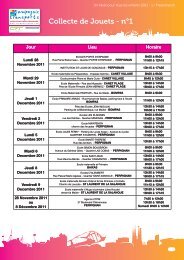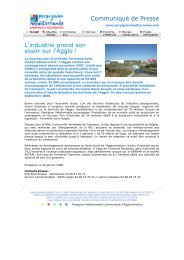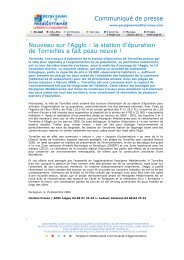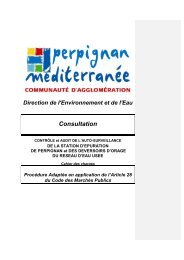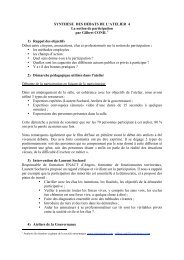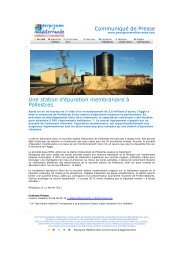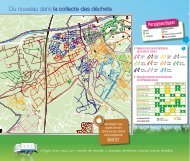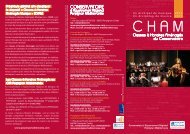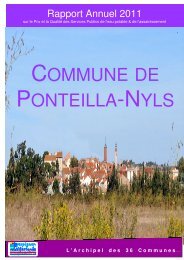eaux - Communauté d'agglomération de Perpignan Méditerranée
eaux - Communauté d'agglomération de Perpignan Méditerranée
eaux - Communauté d'agglomération de Perpignan Méditerranée
- No tags were found...
Create successful ePaper yourself
Turn your PDF publications into a flip-book with our unique Google optimized e-Paper software.
RappoRt pRix généRal <strong>de</strong> l’eau1 ÈRe PARtietableau production <strong>de</strong>s boues 2008, 2009 et 2010 (en tonnes <strong>de</strong> matière sèche)et conformité <strong>de</strong> leur traitementStAtionexPloitAnttonnAGe 2008(tMS)tonnAGe 2009(tMS)tonnAGe 2010(tMS)ConfoRMiteBAHo RÉGie 18 25 36 100 %BAixAS VeoliA 3 4,4 39,10 100 %CAlCe RÉGie CoM. 0,8 NC 0,77 100 %CAnet en RouSSillon SAuR 344 334,96 409,65 100 %le BARCAReS VeoliA 304 237,9 289,5 100 %PeRPiGnAn VeoliA 1940 2318,4 1760,1 100 %PeYReStoRteS RÉGie 13 13,7 14 100 %PeZillA lA RiVieRe RÉGie 16 21 18 100 %PolleStReS SAuR 45 53,77 46,96 100 %PonteillA SAuR 2,42 100 %SAint feliu D’AVAll RÉGie 24 15 25 100 %SAint HiPPolYte SAuR 31 17,76 14,29 100 %SAint lAuRent De lA SAlAnQue SAuR 25 34,8 160,71 100 %SAinte MARie lA MeR SAuR 120 131,85 184,30 100 %SAleilleS RÉGie 75 44 42 100 %toRReilleS VeoliA 80 66,2 66,4 100 %VilleneuVe De lA RAHo* RÉGie 53 48,2 49 100 %VilleneuVe lA RiVieRe RÉGie 8 11 8 100 %ume 3 125,8 3 077,87 3 166,2 100 %la production <strong>de</strong> boues est un bon indicateur du niveau <strong>de</strong>dépollution obtenu par le parc <strong>de</strong> stations d’épuration. en2009 la station d’épuration <strong>de</strong> perpignan a fait l’objet d’unemise au point <strong>de</strong> sa filière <strong>de</strong> traitement <strong>de</strong>s boues par digestion.il s’ensuit une réduction du volume <strong>de</strong> boues produità niveau <strong>de</strong> dépollution constant puisque l’abattementconstaté entre 2009 où la filière <strong>de</strong> digestion a été shuntéeafin <strong>de</strong> réaliser les essais <strong>de</strong> la station d’épuration et 2010 oùla digestion thermophile a fonctionné tout au long <strong>de</strong> l’annéeon constate une réduction <strong>de</strong> 24% <strong>de</strong>s matières sèchesévacuées . par ce tableau on peut voir le résultat environnemental<strong>de</strong>s investissements consentis par la population <strong>de</strong>l’agglomération. ils sont notables lorsque la station d’épurationa été renouvelée (Baixas , Saint laurent).p.22L ’ A r c h i p e l d e s 3 6 C o m m u n e s



